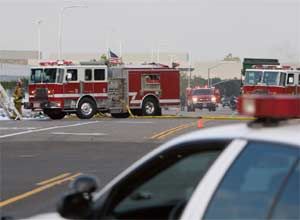
By Hannah Simon
In the past several years, many public safety agencies have redoubled their efforts to fix the various communications interoperability problems that plague them. These problems range from the inability to communicate due to a lack of interoperable technologies used by police, fire, and EMS personnel in different areas, to the inability to organize efficiently across jurisdictions or among agencies within a jurisdiction despite having appropriately interoperable technologies.
In any emergency — whether it's a terrorist threat, a massive forest fire, or a relatively small-scale traffic incident — it's essential that agencies efficiently communicate and work together safely to meet the challenge. In many ways, we're "getting there" from the standpoint of enabling multi-agency interoperable communications, but much more work must still be done.
In a June 2009 report, the National Governors Association (NGA) Center for Best Practices emphasized that public safety interoperable communications remains a challenge in five key areas: informal oversight and governance, uncoordinated standard operating procedures, incompatible and obsolete technology, infrequent and inconsistent training, and difficulty integrating interoperability into routine, daily use.
Further, while the Public Safety Interoperable Communications (PSIC) grant program gave almost $1 billion in funding to agencies across the nation, new technologies are emerging constantly, rendering legacy products obsolete, so systems that today can "talk to each other" may one day be replaced by other technologies that don't have that capability if agencies don’t continuously work together as upgrades are made.
We turned to a group of experts in public safety communications to create a roundtable discussion aimed at the challenges that first responders face, how to solve the problems posed by current communications technologies, and some best practices for collaboration between different public safety departments.
Our panel of experts included Richard Mirgon, President-Elect of the Association of Public Safety Communications Officials (APCO); Chief Mark Marshall, Chief of Police for Smithfield (Va.) PD; Terry Betts, Interoperability Program Director for the Bay Area (Calif.) Urban Area Security Initiative program (UASI); Charles Bailey, fire captain in Montgomery County, Md., assigned to the Communications Section as the Operations Supervisor; and Kris Kaull, Critical Care Paramedic as well as the Online Director for the EMS1.com.
What follows are the highlights of that discourse we hope will kick-start an even broader dialog among public safety professionals, city administrators, and elected officials in cities and towns of every size.
 |
Q: One of the biggest challenges facing public safety communications today is that companies are developing communications products that don’t interface. How can agencies make smart purchases in light of this issue?
Richard Mirgon: When you're making purchases, look for equipment that meets established interoperability standards. Also, reach out to your partners and collaborate so that agencies within a jurisdiction can agree on what kind of products to use.
Mark Marshall: Information sharing is one of the top buzzwords in public safety right now. The average chief or commander can become overwhelmed with what’s going on in the evolution of technology products, especially if a smaller agency doesn’t have the capacity of IT support. Whoever is making the purchases at the agency should do extensive research and planning so that they aren’t at the mercy of the vendor.
Charles Bailey: Currently we have a large range of tools at our disposal. Being part of a large metropolitan area with cooperating jurisdictions, we share from good funding streams, cooperation, and shared resources. Beyond the day-to-day 800 MHz trunked systems, systems with overlapping coverage, we have a range of deployable gateways, console patches, and other tactical communications assets. These are supported by conventional voice radio channels as tertiary back-ups and simple interoperability tools like caches of portable radios.
Terry Betts: By staying current on the latest developments in the technology world, one can "read" the future to some extent. Buying systems that are scalable and open to change as technology advances is something we haven’t looked at in the past, but with most systems becoming IP-based, newer technology is software upgradeable. Ask questions like "What is the cost?" "Do we need the highest tier (a.k.a. the most expensive model)?" "How long will the product last and how easy is it to use?" "Is it standards-based?" "What is the turnaround time for repair and will it do the job it is required to do?"
Kris Kaull: Technology purchases should meet the needs for the majority of the people involved, should be dynamic so that the products can adapt to new demands, scalable so that despite growth you won't have to rebuild, and should be within your budget and timeline.
The Bottom Line: While making decisions about communications technology, it’s important to keep neighboring agencies in mind. If you're faced with an emergency but can’t reach out to other departments during the crisis, chaos and confusion will ultimately prevail.
Take Hurricane Katrina, for example. Occurring nearly four years after 9/11, hundreds of resources were deployed into the affected states but the first responders still had no way to communicate with each other and distribute the resources where they were most desperately needed.
Since Katrina, there has been a lot of progress made, but we’re not "there" yet. Keep your lines of communication open in the planning process (working groups, training, planning, etc.) and you will help enable that same level of collaboration on "game day" when disaster strikes.
Q: What can agencies do to increase communications efficiency besides jointly applying for funding toward new technologies?
Bailey: The way to get good collaboration with a radio system is to have good collaboration before the radio system. All the users have to sit down and do realistic needs assessments. They have to build relationships. Shared spaces on a radio 'fleetmap' represent solid relationships. The group has to sit down and figure out who exactly needs to talk to whom and how often does that need to happen. Sure, the fire department needs to be able to communicate with the Sheriff's Department in a crisis, but should that happen on a shared channel or 'talkgroup' or should that happen face to face? These are the sorts of things that have to be worked out. As far as the technology goes, you figure out what you need first — then buy the simplest thing that gets that need met.
Mirgon: Departments need to reach out and embrace neighboring jurisdictions for training and partnership. Both small and large jurisdictions need each other as mutual aid partners. Smaller jurisdictions understand the need for collaboration because they find they get a bigger bang for their buck, but larger jurisdictions don’t have quite the same need to reach out to smaller agencies. Sometimes there's a rift between agencies, but we need to get over those rifts and start doing what's best for public safety and taxpayers.
Marshall: Working across agencies is definitely important — public safety officers should be working together to build equipment and infrastructure and participate in planning exercises. Collaboration is the only way that you're going to get anything done. If you think you're a stand-alone agency, good luck to you, because these are the times when we all need to be working together.
Betts: Share resources. Stovepipe systems are no longer feasible to share information. Collaboration politically and in technology allows for seamless interoperability.
Kaull: Technology isn’t a solution, it's a tool. The solution may be that we all work at the same standard operating procedures, or apply the right kind of technology to meet a community's needs. For departments with limited resources or those in rural areas, it's critical that all public safety officers are on the same page. It's not about "us vs. them" — it's about focusing on what our outcome is and the specific steps we need to take to get there.
The Bottom Line: Public safety experts agree that sharing resources is one of the best ways for agencies to get the most "bang for their buck" in making technology infrastructure purchases and building out of their communications capabilities. In addition, agencies and their individual units of police officers, firefighters and EMTs — as well as the leadership in these agencies — have to make collaboration their standard operating procedure, not the domain of the "big event" that comes every so often.
From a technological standpoint, one of the best ways to ensure that information is easily exchanged is for regional agencies to commit to working toward using standard technologies. This guarantees that even when new infrastructures are built, the products your department has purchased will have an evergreen path to migrate within as new technologies become available.
Q: What are some other ways that public safety agencies can reach out to promote communications collaboration?
Bailey: I think it's important to realize that interoperability, while a simple concept, has many layers to it. On the simplest level it means that Jurisdiction A carries an extra radio for the times when they interact with Jurisdiction B. You can also use technology like gateway devices, console patching and other things to make this work too. The key again is asking some fundamental questions before you get started. Then after you answer the questions for yourself you have to sit down at the table with your partners to figure out the rest.
Mirgon: It really comes down to education, awareness, leadership, setting standards, and turning to local governments.
Betts: Creating collaboration politically is key. The federal government has helped this along tremendously in that grant allocations are prioritized based upon regional cooperation and implementation.
Kaull: Cooperation in public safety isn't limited to EMS, fire and police officers and it’s not just getting some chiefs together. You also have to take government employees, hospital staff, communication dispatch centers, and search and rescue teams into consideration. Build a working group of one or two people from each agency to work out a technology plan — brainstorm needs, strengths, and weaknesses of technologies in place, build a technology plan, and continually modify that plan.
The Bottom Line: Because technologies are constantly adapting and evolving, the public safety sector will forever be faced with challenges in sharing information and communicating across agencies.
We hope that this roundtable conversation among some of your peers has given you some helpful insight.
More important, we hope it provided an impetus for you to carry this discussion forward — within your agency, among first responders with agencies in your jurisdiction, and with the other individuals in your region who one day may be the people with whom you'll work during a major catastrophe.
Jamie Thompson and Doug Wyllie contributed to this report.
Copyright © 2024 FireGrantsHelp.com. All rights reserved.
